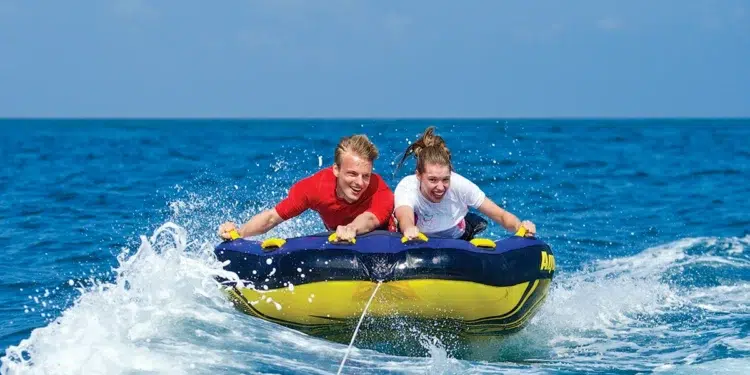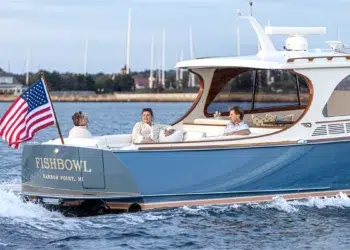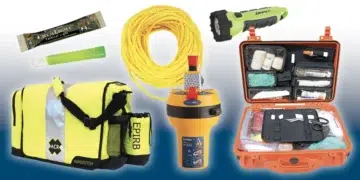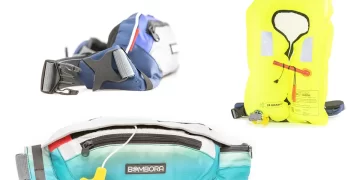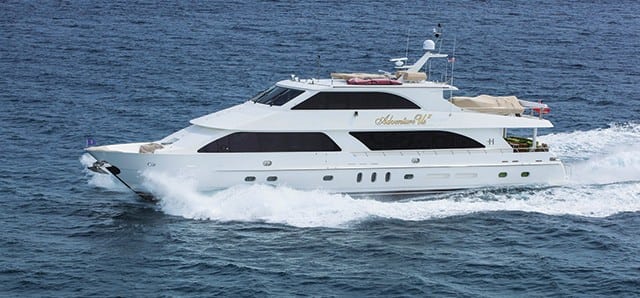Water Toys
Towing water toys takes some planning. Boaters pulling skiers, kneeboarders, wakeboarders, and thrill-seekers on tubes and other water toys need to be aware of applicable regulations. Requirements can vary, but each state does have them. There are observer requirements, ski mirror(s), minimum age, designated open or ski zone areas, and other specific rules in their statutes.
In the world of recreational marine towables, there is an almost infinite variety of water sleds to a slew of one- to four-person inflatables, pool loungers that convert to a sit-in or lie-on towable, some with a sunshade, tiltable seat, adjustable pillow, and even a tether strap to keep one stationary if indulging in a nap. One company has a full line covering every category from one- to four-person discs to sit-upons, and all kinds of hybrid shapes with attention-grabbing colors and graphics.
Also Read
Hinckley’s Picnic Boat 39 Review: Quiet Speed, Big Views
Imagine a beautiful day. Visualize a traditional wicker basket filled with tasty delicacies, a cooler with refreshments on ice, and...
Water toys offer a fun, wet ride but for safe rides towing drivers must comply with the boating laws, plus common sense. Most laws are fairly typical overall. Wear a PFD while water skiing, riding a tube, or being towed behind a vessel in any manner; being under the influence of alcohol or drugs is forbidden; and when towing an individual, there must also be an observer at least 12 years old or a wide-angle mirror positioned so the operator can view the person being towed. (For a personal watercraft, there must be two rearview mirrors or an observer). And the boat’s operator may not manipulate or control the boat causing the person(s) being towed to collide with any object or person. Towing is prohibited “during inclement weather” and from sunset to sunrise.
Several other considerations for safeguarding those towed: Do not run parallel to the shoreline in shallow water to drop off the towed person; rather, keep a distance and let the towed person swing into shore; check the prop and towline before each outing for wear; turn off the engine before approaching closely to someone who has fallen during a towing activity and approach from the driver’s side to not lose sight of them; and establish communication (e.g., hand signals) between the operator and those towed.
Subscribe Here For More Boating Content
The U.S. Coast Guard says drivers should complete a boating safety course (required in many states for younger operators) and reminds about always wearing a life jacket. Water sports competitors wear one, and these hard-core types have ones that are not only fashionable, but more importantly, highly functional and have extra padding for the lower back.
The National Association of State Boating Law Administrators also developed a model act known as the Safe Practices for Boat-Towed Watersports in its efforts to help guide states in adopting regulations relating to water sports activities.
Drivers need to scan constantly for people (don’t be careless or reckless by going near swimmers and doing the spray routine, especially within 100 feet of one of those swimming zones), and watch for objects and obviously other watercraft, including those also towing skiers or tubers. Be alert for conditions limiting visibility or blocking vision.
Also Read:
Hinckley’s Picnic Boat 39 Review: Quiet Speed, Big Views
Imagine a beautiful day. Visualize a traditional wicker basket filled with tasty delicacies, a cooler with refreshments on...
A driver also must watch for possible accumulation of debris near the edges of waterways, a common phenomenon. In a real personal injury case, a rider was in an inner tube pulled by a powerboat on a canal by her companions who were inexperienced boaters. She was also unskilled in riding an inner tube-type water toy in a boat wake. As the boat made a turn, the tube strayed outside the wake and carried its passenger into shallow water near the shore where she struck one of several cement blocks lying two or three inches below the surface of the water.
In another case, parents placed their two kids in a water toy, picked out an open stretch of water, pulled them for a few loops, and turned back into the wake for a bounce. They were thrown out and retrieved, but the unmanned tube skimmed a kayaker that had seemingly come out nowhere causing him to flip. The lesson here as with all boating activity is to be extremely alert every second while on the water.
-by Joan Wenner, J.D.


